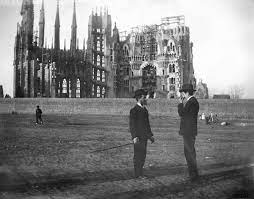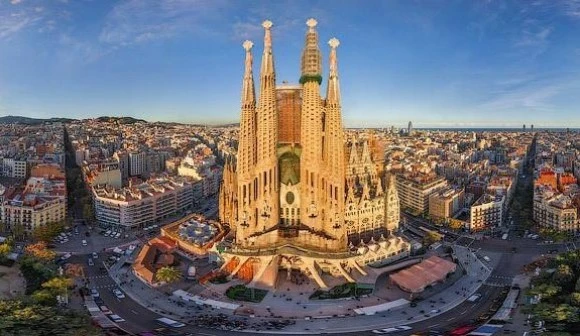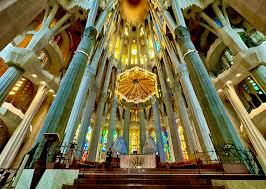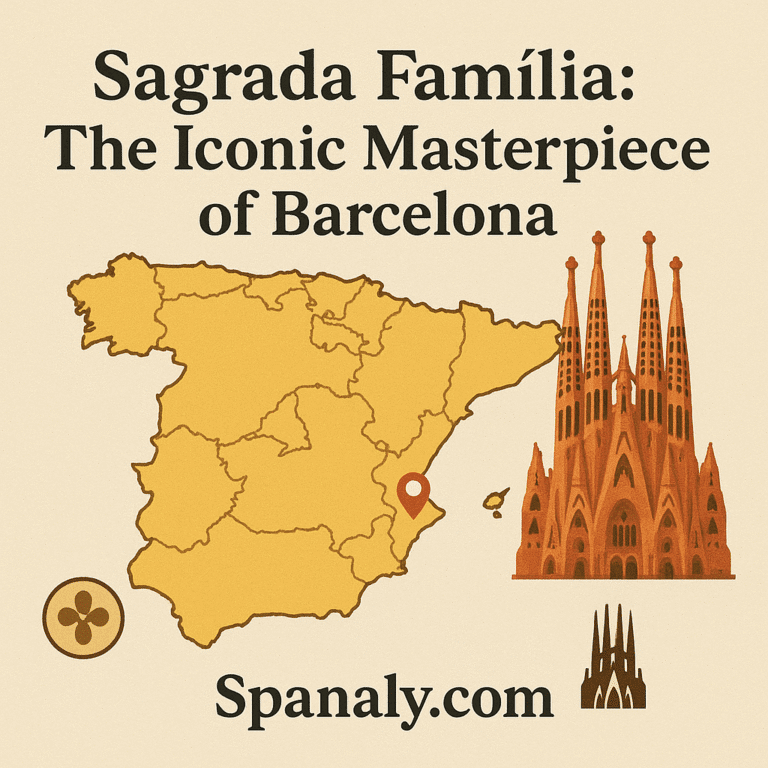Barcelona, a city where history dances with modernity, art blends seamlessly with life, and architecture tells stories of centuries, proudly hosts a marvel unlike any other: the Sagrada Família. For a full travel guide covering all major attractions, transport, dining, and accommodation in the city, see our Ultimate Barcelona Guide. This basilica is not just a building—it is a living testament to human imagination, faith, and artistic genius, a creation that has fascinated architects, historians, and travelers for over a century.
For anyone visiting Spain, the Sagrada Família is not merely a sightseeing destination; it is a journey into the mind of Antoni Gaudí, a place where stone and light merge to narrate stories of nature, spirituality, and Catalonia’s identity.
In this guide, we explore every dimension of the basilica—from its rich history to architectural innovations, hidden symbols, visiting strategies, and unique experiences—making this your definitive reference on Sagrada Família, available exclusively on Spanaly.com
Table of Contents
ToggleHistorical Background: From Vision to Reality

Construction of the Sagrada Família began in 1882, initially led by Francisco de Paula del Villar with a traditional neo-Gothic design. A year later, Antoni Gaudí took over, completely redefining the project into an ambitious synthesis of Gothic grandeur and Art Nouveau innovation.
Gaudí devoted the final 15 years of his life exclusively to the basilica, often living on-site, sketching, carving, and experimenting with new structural techniques. His death in 1926 did not halt the dream; craftsmen, architects, and scholars have continued the work, striving to remain faithful to his vision. Today, the Sagrada Família remains unfinished, with projected completion in the late 2020s, making it one of the longest-running architectural projects in history.
This ongoing construction is not a drawback but a living feature of the basilica, illustrating that art is an evolving dialogue across generations.
Gaudí’s Vision: A Fusion of Styles
The genius of Gaudí lies in his ability to merge architectural styles seamlessly. He combined:
Gothic Elements: Verticality, pointed arches, and intricate stone carvings.
Art Nouveau Flair: Organic shapes, flowing lines, and naturalistic motifs.
Nature as Inspiration: Columns branching like trees, spiral staircases like shells, and facades filled with flora and fauna motifs.
Gaudí’s philosophy was rooted in nature, symbolism, and fluidity. His genius is clearly evident in this basilica, but also in his domestic works like Casa Batlló & Casa Milà – Gaudí’s Barcelona Icons, and the public space of Park Güell: Gaudí’s Colorful Masterpiece in Barcelona. Every curve, mosaic, and iron detail in these houses carries meaning.
Gaudí’s philosophy was that architecture should imitate nature, creating spaces that inspire awe while feeling naturally harmonious. Every detail, from the curvature of a column to the arrangement of stained-glass windows, reflects a meticulous observation of the natural world
Exterior Highlights: Façades and Symbolism
The basilica has three principal façades, each narrating a chapter of Christ’s life:
Nativity Façade (East): Celebrates the birth of Jesus. Abundant with joyful sculptures, angels, and wildlife motifs. The only façade completed during Gaudí’s lifetime.
Passion Façade (West): Dramatic, minimalistic, depicting Christ’s crucifixion. Designed to provoke contemplation and emotion through stark lines and intense shadows.
Glory Façade (South, under construction): Will represent the path to heaven, eternity, and spiritual transcendence, featuring intricate symbolism of the sacraments and virtues.
Fun Fact: Each façade is oriented with natural light in mind, creating different moods at various times of day—sunrise on the Nativity Façade and sunset on the Passion Façade

Interior Wonders: Nature, Light, and Structure
Inside, the basilica is nothing short of a forest made of stone and light:
Columns as Trees: Branching structures support the roof while creating a canopy-like atmosphere.
Stained Glass Windows: Each window casts colored light corresponding to the theme of its side—warm colors for the Nativity, cooler tones for the Passion.
Geometric Genius: Hyperboloids, helicoids, and catenary arches create stability and elegance simultaneously, reducing the need for heavy supports.
Gaudí’s interior design is a masterclass in spatial harmony, blending functionality with spiritual symbolism. The nave feels both vast and intimate, evoking reflection and wonder in equal measure.

The Towers: Panoramic Views and Apostolic Symbols
Visitors can climb or take elevators up select towers, each representing significant biblical figures:
12 Apostles Towers: Surround the central nave.
Virgin Mary Tower: Dominates the nativity side.
Jesus Christ Tower: The tallest, representing resurrection and eternal life.
From these heights, one can admire Barcelona’s skyline, the Mediterranean Sea, and Gaudí’s intricate craftsmanship up close. Each tower is adorned with sculptures, mosaics, and symbols only visible from certain angles—secrets for observant visitors
Hidden Details & Artistic Secrets
Sagrada Família is filled with hidden gems and symbolism rarely highlighted in travel guides:
Animals and Plants: Birds, lizards, and fruit motifs represent life and creation.
Geometric Codes: Gaudí embedded mathematical sequences and natural proportions into columns and arches.
Astrological Symbols: Certain facades align with celestial events, like the winter solstice, highlighting Gaudí’s blend of science, art, and spirituality.
This depth makes the basilica a paradigm of interdisciplinary genius—architecture, mathematics, theology, and art converge in one monumental space
Visitor Tips & Experiences
Tickets: Always book online in advance. Consider early morning to avoid crowds.
Guided Tours: Professional guides or high-quality audio tours reveal hidden symbols and construction techniques.
Photography Tips: Sunrise and sunset provide the most dramatic lighting for facades.
Events: Attend a mass or special service to experience Gaudí’s spiritual intent firsthand.
Accessibility: Elevators available, but some towers require climbing.
Extra Tip: Visit the museum underneath the basilica to see Gaudí’s original models, sketches, and 3D designs—insights impossible to grasp from just walking around.
Cultural Impact & Legacy
The Sagrada Família is not just a tourist attraction; it is a symbol of Catalonia, representing resilience, creativity, and faith. Its influence extends to:
Inspiring modern architects worldwide.
Being featured in films, literature, and art.
Serving as a focal point for Barcelona’s identity and tourism.
Declared a UNESCO World Heritage Site, it continues to attract millions of visitors each year, who leave not only with photographs but with a sense of connection to human genius and spirituality
A Living Monument of Creativity
The Sagrada Família is a once-in-a-lifetime experience. It is a testament to human imagination, a living dialogue across centuries, and a symbol of Barcelona’s soul. From the forest-like interior to the towering façades, from secret geometric codes to breathtaking panoramic views, every corner tells a story.
No other site in Spain—or the world—blends history, art, mathematics, and spirituality so profoundly. Visiting the Sagrada Família is not just sightseeing; it is stepping into the mind of a genius, witnessing a dream still unfolding, and leaving with a sense of awe and inspiration that lingers long after you depart.
Spanaly.com brings you this comprehensive, exclusive guide so that your journey through Gaudí’s masterpiece is not just informative but transformative. For more essential stops and planning advice, be sure to Discover Barcelona: Top Attractions and Travel Tips.
❓ FAQ – Sagrada Família
When was the Sagrada Família built?
Construction began in 1882 and is still ongoing, following the original designs of architect Antoni Gaudí.
Who designed the Sagrada Família?
The Sagrada Família was designed by Catalan architect Antoni Gaudí, renowned for his unique modernist style.
What are the main features of the Sagrada Família?
Key features include its towering spires, intricate facades, colorful stained-glass windows, and detailed sculptures depicting biblical scenes.
Is it necessary to book tickets in advance?
Yes, it is highly recommended to purchase tickets online in advance, especially during peak tourist seasons.
Can visitors access the towers?
Yes, visitors can access some of the towers for panoramic views of Barcelona, subject to availability and safety restrictions.



[…] city where modernist architecture meets Mediterranean charm. Visitors are captivated by Gaudí’s Sagrada Família, the colorful mosaics of Park Güell, and the vibrant streets of Las Ramblas. Barcelona also offers […]